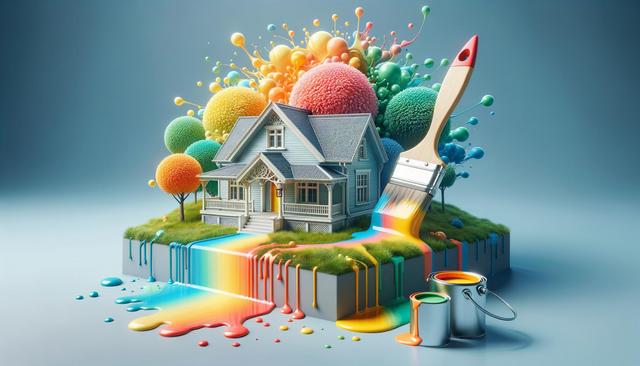Transform Your Home: The Art and Science of House Painting
House painting is a crucial aspect of home maintenance that enhances aesthetic appeal and protects surfaces.

The Importance of House Painting in Home Care
House painting does much more than refresh a building’s look—it plays a vital role in preserving the integrity of your property. Over time, external surfaces are exposed to sun, rain, wind, and other environmental factors that can cause deterioration. A good coat of paint creates a barrier against moisture and pests, preventing issues like mold, rot, and insect infestation. Internally, painting helps maintain clean, vibrant living spaces while covering imperfections such as stains, cracks, or general wear and tear.
When planning a house painting project, homeowners often consider both functionality and design. Choosing colors that reflect personal taste while complementing architectural elements can enhance the overall curb appeal. For those interested in unique aesthetics, incorporating elements inspired by Amazing Art Paintings or opting for Cool Paintings for Bedroom can make interior spaces more personalized and inviting.
Understanding Surface Preparation and Paint Selection
One of the most overlooked yet essential steps in house painting is surface preparation. A properly prepared surface ensures better paint adhesion and longevity. This includes cleaning, sanding, patching holes, and sometimes priming the walls. Skipping these steps can lead to premature paint failure, costing more in the long run.
When it comes to choosing paint, factors like finish, colorfastness, and environmental impact come into play. Homeowners now have access to a wide variety of eco-friendly paints that reduce indoor air pollution and are safer for families and pets. Whether you’re inspired by Cool Paintings found in modern galleries or want to reflect the creativity of Artist Art, selecting the right paint can elevate your environment significantly.
Here are some key considerations when selecting paint:
- Matte finish for hiding surface imperfections
- Semi-gloss for high-traffic areas that require easy cleaning
- UV-resistant paint for long-lasting exterior applications
Color Psychology and Interior Design Harmony
Color choices in house painting can significantly influence mood and atmosphere. Warm tones like beige, soft red, or gold can create a cozy ambiance, while cooler tones such as blue and green promote relaxation and calmness. Understanding color psychology helps in making informed decisions that enhance the overall comfort of a home.
Many homeowners draw inspiration from Cool Paintings for Sale or artwork that resonates with them. This can lead to cohesive interior design where wall colors harmonize with furniture, textiles, and decorative elements. For example, soft grey walls might beautifully offset colorful Artist Art pieces, creating a balanced visual impact that feels both curated and inviting.
Some popular color schemes include:
- Monochromatic tones for a minimalist look
- Complementary colors for striking contrast
- Analogous colors for a more harmonious flow
Tools, Techniques, and Professional vs. DIY Painting
House painting can be undertaken as a DIY project or by hiring professionals. Each option has its benefits and considerations. While DIY painting can be cost-effective and rewarding, it requires time, skill, and the right tools. Professionals, on the other hand, bring efficiency and experience, especially for large-scale or complex jobs.
Common tools used in house painting include:
- Rollers and brushes for different surfaces
- Painter’s tape for clean lines
- Drop cloths to protect floors and furniture
- Ladders and scaffolding for high areas
Proper technique is also essential. This includes using the right stroke methods, maintaining a wet edge to avoid lap marks, and applying multiple coats for even coverage. Whether you’re refreshing a room with Cool Paintings for Bedroom as inspiration or updating an entire exterior, proper execution yields long-lasting results.
Maintenance and Long-Term Benefits
Once the painting is complete, regular maintenance can extend the life of your paintwork. This includes simple practices such as washing walls, touching up scuffs, and monitoring areas prone to moisture or sun exposure. For exteriors, annual inspections can help catch peeling or fading before it becomes widespread.
Investing in quality paint and proper application pays off over time. Not only does it preserve structural elements, but it also contributes to a home’s market value. A well-painted home suggests care and attention, often translating into better first impressions and higher resale potential. Drawing from themes found in Amazing Art Paintings or incorporating Cool Paintings into your decor can also make your home stand out in meaningful, artistic ways.
Regular upkeep might include:
- Cleaning dirt and mildew from the exterior
- Checking caulking and sealing gaps
- Repainting high-wear areas every few years
Conclusion: Enhancing Your Home Through Thoughtful Painting
House painting is both a practical necessity and a powerful design tool. It protects your investment and allows you to express creativity within your living space. Whether you’re inspired by Cool Paintings, seeking Cool Paintings for Sale, or simply aiming to refresh your surroundings, a well-planned painting project can transform your home in lasting ways. By understanding the techniques, choosing the right materials, and maintaining the results, homeowners can enjoy the beauty and benefits of thoughtful, high-quality painting for years to come.